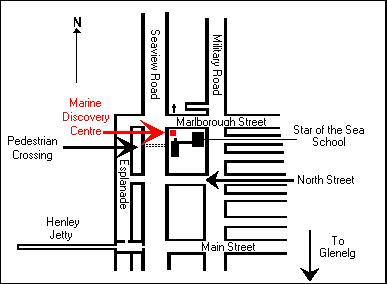
MLSSA
Newsletter
MAY 2003
No. 299
"Understanding, enjoying & caring for our oceans"
Next Meeting
Our May AGM will be held at the Star of the Sea Marine Discovery Centre situated at the corner of Seaview Road and Marlborough Street, Henley Beach on Wednesday 21st May commencing at 7.30pm.
Our speaker will be the Centre Coordinator and MLSSA member Tim Hoile who will explain the working of the Centre.

Map showing the meeting place.
Please bring a plate of food to share during the break to help celebrate the AGM.
Contents
Applying Pain Theory In Fish Spine Envenomation Pt 2
MV Falie Part 3
After The Encounter Part 5
Cleanup Dive At Port Hughes - 2/3/03
Committee Reports
Non Executive Reports
Membership Fees
Committee Elections
The following nominations have been received:
President - Philip Hall
Secretary - Steve Reynolds
Treasurer - Phill McPeake
2 Committee Members
1 - David Muirhead
2 - Chris Hall
Under our Constitution only nominations listed in this Newsletter for the Committee may be considered. When there is only one nomination for a position then no election will be necessary.
The non-executive positions will be nominated at the AGM. Everyone is encouraged to take a position to spread the load. These positions are: Editor, SDF rep., Conservation Council rep., Reefwatch rep., Social officer, Photo Index officer, Website manager, Librarian and Auditor.
It is also a good idea to have assistants for many posts to share the work and in case of illness or unexpected absence.
Applying Pain Theory In Fish Spine Envenomation
By David Muirhead
Part 2
The references listed will be given in the final part of this article.
If one reviews current pain theory,4,5 support for the role of Gate Control and DNIC pain theories in fish spine envenomation may be found in the extensive range of fish species whose spine envenomations are known to respond to hot water immersion. This is specifically with regard to local pain relief as opposed to any systemic sequelae of envenomation. It even appears probable that envenomations from creatures in other phyla such as Cnidaria6 will respond to thermal treatment, and application of icepacks is already an accepted first aid analgesic measure for jellyfish stings.
Examples do exist in the marine environment of identical or nearly identical toxins being utilized defensively by phylogenetically disparate organisms, notably tetrodotoxin in puffer fishes (vertebrates) and blue-ring octopi (invertebrates). However, it seems improbable that hundreds, even thousands of marine animal species share toxins so similar that they are all inactivated by such a conveniently small elevation in temperature.
A comprehensive worldwide literature search via Medline dating back to 1966, has failed to find a single study whose specific aim was to demonstrate heat-labile properties of non-scorpaeniform fish spine venoms. A limited number of papers were found purporting to delineate haemolytic, dermonecrotic, oedema-promoting, vasospastic, and lethal components of catfish venom and skin toxins.7
These include studies of the oriental catfish (Plotosus lineatus),8 North American species,9'10 and the comparative toxicity of two catfish genera Ictalurus and Schilbeodes.11 None of the above studies addressed heat-lability.
As long ago as 1966, Pacy in his review of Australian catf
ish injuries proposed, largely on the basis of a single case report involving a long-tailed catfish (Family Plotosidae, genus Plotosus), that the venom had vasospastic properties as well as possibly transient neurotoxic effects.12Pacy stated:
"Fish venoms tend to become rapidly inactive by change of pH (Wiener, 1960) and therefore instantaneous irrigation of the wound channel with sodium bicarbonate solution...is likely to destroy much of the poison."
and:
"As stingray venom is destroyed by temperatures above 60°C the possibility of this applying to catfish venom cannot readily be excluded. However, it is the great symptomatic relief that indicates hot bathing."
Pacy refers to earlier work specifically on stingray venom, and the quoted minimum temperature of 60°C needed to destroy venom would seem to negate the relevance of heat- lability as the major reason for the effectiveness of hot water immersion in stingray envenomation.13,14
However, Pacy’s case report does contain the following statement:
"The patient repeatedly tried to take her hand out of the hot water, in order to get some sleep, but immediately the hand was withdrawn, the pain returned within a few seconds, disappearing only after renewed immersion."
This account perfectly matches my own experience, and is supported by a prospective observational case series of 22 fish stings, at least eight of which were from catfish, where hot water immersion treatment was completely effective in 73% of cases
.15
Easter 2002
by Chris Hall
PART 3
Next day dawned a beauty. No wind, clear skies and an estimated temperature of 21°C.
We breakfasted again on another feast then headed up on deck to survey the lie of the land. Kangaroo Island was about a kilometre off our starboard side.
Kangaroo Island is the third largest island of the Australian coast and is approximately 145 kilometres long and 45 kilometres wide. At its nearest point it is about 20 kilometres from the mainland. It is served by two car ferries and an air service. The main industries are farming and tourism and certainly provide South Australia with its best tourist destination.
I digress.
Up on the wheel deck a few of us got chatting to the coxswain and he tells us we’re heading for the Portland Maru, a shipwreck.
The demise of the Portland Maru occurred in 1935 as a grain carrier.
Built in 1919 and weighing 5865 tons the Portland Maru was a steamer 385 feet long, 51 feet wide with a draught of 36 feet. Having been loaded with grain at Port Pirie she set sail but called into Port Lincoln to be examined by divers because she had a slight list probably caused by poor loading. The ship’s master satisfied everything was OK, he decided to continue the journey. Off the coast of Kangaroo Island she apparently struck an unidentified object. The master decided to head to Port Adelaide for repairs but she began to settle in the bow. When it became obvious that she wouldn’t make port it was decided to beach her just west of Cape Torrens, KI. The crew was transferred to the tug Wato and the ship was left to the sea. Swept by moderate seas she began to break up where she now provides a haven for marine life and a most enjoyable dive.
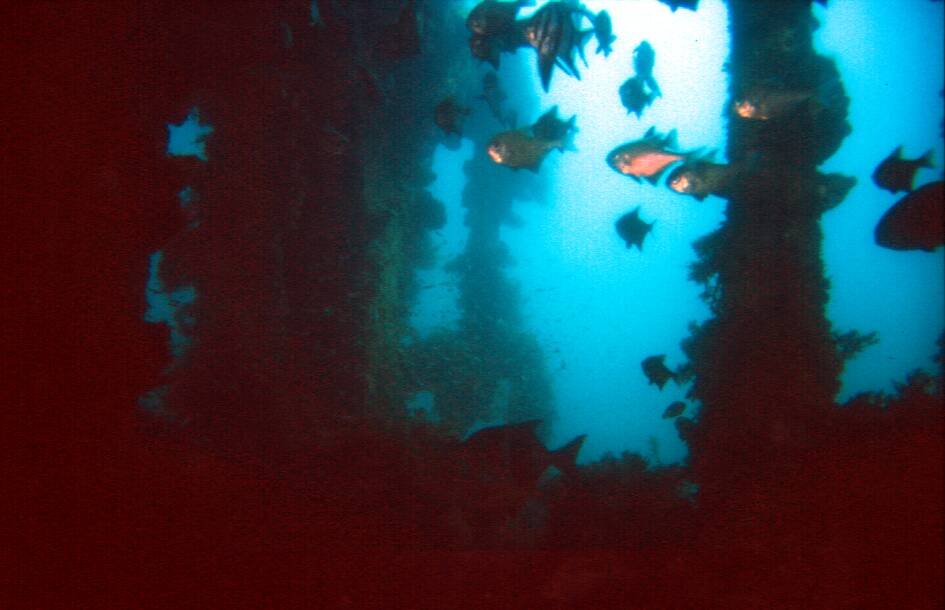
Portland Maru
Having arrived at a small bay we dropped anchor and the boats were lowered. The crew went off in search of the wreck and was back twenty minutes later having secured a marker on the wreck. The weather was now perfect for diving, no wind and a flat sea. The first dive groups kitted up and were off in no time at all, anxious to get wet. We waited our turn and enjoyed some idle chitchat, patiently awaiting the return of the first dive groups as we were now swapped around and last to go. Finally our turn came and we were off and in the water, enjoying another great dive.
I would consider this the best wreck dive I’ve had in South Australia, not because of the remains of the wreck but the marine life it supports, especially for the variety of fish.
The wreck lies in about 15 metres of water and covers a reasonable area, certainly large enough to keep most divers occupied until they get to 50 bar. The visibility was 8 to 10 metres but I imagine it could be much better depending on the time of year.
As a photographer I found this a great dive site for fish subjects.
Diving down to the wreck you pass the boilers and end up on the bottom by some of the structure forming an arch. This is just full of schooling fish such as bream, silver drummer, bullseyes, sea and banded sweep. Before finning through the arch I took a couple of photos, one of a red snapper and the other a swallowtail. Having finned through the arch you then end up by the boilers towering up about 3 or 4 metres. Looking up at the boilers about a metre away were two large western blue groper hoping for a free feed of abalone. These two, a male and female, seemed to follow me for most of the dive.
In the protection of the boilers were a number of juvenile barber perch attended by a few adults. A few more photos. Swimming right round the boiler and accompanied by the blue gropers I came across a large area of algae where a number of elusive herring cale were darting about. I patiently settled on the bottom and attempted to photograph these elusive subjects but only managed to get a mediocre shoot of a female not the more colourful male.
Further on, resting on the bottom was a sergeant baker, a first sighting for me. They make good subjects because they just sit on the bottom amongst the seaweed. A couple of more snaps and onto the next subject. Another poser, a rainbow cale was about a metre away so I got a couple of shoots for the photo collection.
The male western blue groper was still following me around and getting quite tame so I decide to get a good close up his of his head, big lips and close enough to kiss.
By now I was starting to run out of film so I decided to try and photograph some trachinops which can be quite difficult. One shot turned out OK.
Two pictures left so I decided on an elusive grooved-cheek goby, one was rubbish and the other was OK.
A very successful dive in relation to photography but also a very enjoyable dive, especially when you're looking through a viewfinder of a camera. I’d recommend this dive to any diver, the only draw back being its accessibility.
Returning to the surface I was met by the boat and back on board the Falie enjoying morning tea before I realised the dive was over.
After morning tea we milled around enjoying the tranquil surroundings while the crew made ready for our departure. It was only a short trip and made even shorter as we were treated to another exquisite lunch. Being well fed and watered I headed back on deck to peruse our new dive site. We had anchored in a half moon shaped bay with a rocky cliff-line. A light breeze had got up but could hardly be seen on the mill pond sea. This was idyllic. The hustle and bustle of the crew as the readied the boats for the next dive broke my tranquillity. I found a secluded spot and reflected on the last couple of days and was surprised as I was awoken from my daydreaming by the commotion of the divers returning. I quickly kitted up and was in the boat without any delay.
Again this was another good dive. The conditions were perfect, good vis, no current or surge and plenty of marine life. I spent a fair proportion of this dive trying to photograph two juvenile fish, a moonlighter and a barber perch. Being juveniles they were very small and skittish and therefore very hard to photograph especially when you have the wrong lens on the camera. Anyway I persisted but not to any great success.
However I did get some good photos. The diversity of marine life around Kangaroo Island is just amazing.
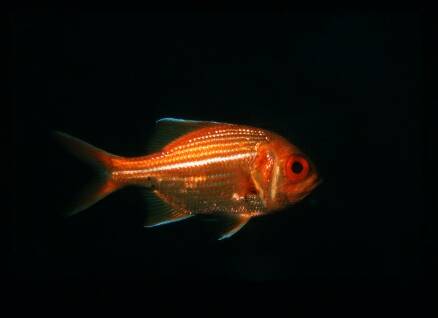
Red Snapper
The air supply exhausted and a roll of film exposed it was time to surface.
Back on board the Falie the wine and beer was flowing for those that were not night diving. Those of us that were had to suffer in silence. Nibbles were passed all round and there was plenty of soft drink to wash away the salt. We relaxed and again swapped stories of deeds past, a few a bit tall but what the heck we were all enjoying ourselves. Our revelry was interrupted by the dinner bell so off we went to another repast of outstanding quality.
Dinner over and those of us that were night diving readied ourselves. Not every body was diving so they managed to fit everyone into two boats. I decided not to take my camera as it was my first night dive for a couple of years and I wanted to have a quiet dive not looking through a viewfinder.
Over the side of the inflatable and a few buddy checks it was time to dive into the dark abyss that awaited us. We reached the bottom at about 15metres carried out a few checks and decided on which direction to head. It was then that I noticed something in a crevice. At first glance I thought it was an eel or a ling but then it revealed itself as a tentacle about 60cm long and then with the body and it was probably over a metre long from the top of its head to the end of the tentacle.
It was an octopus and certainly the largest I’d ever seen. It was now I regretted not having my camera. We observed the octopus for a minute or two but it had gone right up the crevice and into a small cave. Since that dive I have identified it as a Maori octopus. I find octopuses fascinating a certainly my favourite marine invertebrate. We left the creature in peace and continued with the rest of the dive. There was plenty of fish life as usual, blue gropers, various leather jackets and wrasses, sea urchins, seastars, crabs and lobsters. For all the plant life freaks there were red, green and brown algae, bryozoans, sponges, soft corals and gorgonians, etc. etc. Certainly plenty of life to keep us entertained for 40-50 minutes. It was also great to night dive again as nocturnal creatures and their activities make it a special experience.
We returned to the Falie all excited at having a great night dive. With the gear stowed it was off for a nice hot shower. Refreshed, it was time for refreshments and tales of deeds passed. The chat only lasted a short while for those of us that had had three dives that day as our bunks were calling out to us. We retired for the night to dream of dolphins, whales, etc. and be lulled to sleep by the gentle sway of the ship at anchor.
Part 5
By Steve Reynolds
On Friday 5th April Foreign Affairs Minister, Alexander Downer, exchanged gifts with French Ambassador Pierre Viaux and Rear Admiral Francois Bellec of the Terra Australis Association in Paris. Bellec was representing the Association’s President, former French Prime Minister Michel Rocard.
Then came the big one – the Encounter Weekend at Victor Harbor and Port Elliot. This was the weekend that the actual meeting of Flinders and Baudin in Encounter Bay 200 years earlier was to be celebrated.
The events got started on Friday 5th April with a community event called "Three Visions of the world coming together". The SA Maritime Museum’s travelling exhibition was open at the SA Whale Centre from 31st March to 8th April. The Whale Centre’s own exhibition "Encounters of the Fleurieu – Dreamtime and Discoveries" had been running since 15th February.
Associated events included a bowling tournament, a ball, dinner dance, food, flora and wine festival, a community concert of local talent, luncheon, commemorative ceremony, celebration concert, fireworks, petanque games and combined church service.
On Sunday 7th April there were another two performances of "Two Captains", the musical tribute written by Rosemary Nairn and performed by the 60-piece Unley Chamber Orchestra and the SA Country Choral Association. They were both held in the Victor Harbor Recreation Centre, the first one at 2.30pm and the second one at 6pm. Our Governor, Marjorie Jackson-Nelson was present for the first performance.
I couldn’t attend a performance myself but I was fortunate to be able to borrow a video tape of one from our President, Philip Hall. I enjoyed the viewing experience.
All four tall ships and the Vendemiaire were there in Encounter Bay for three days from mid-afternoon Saturday 6th April.
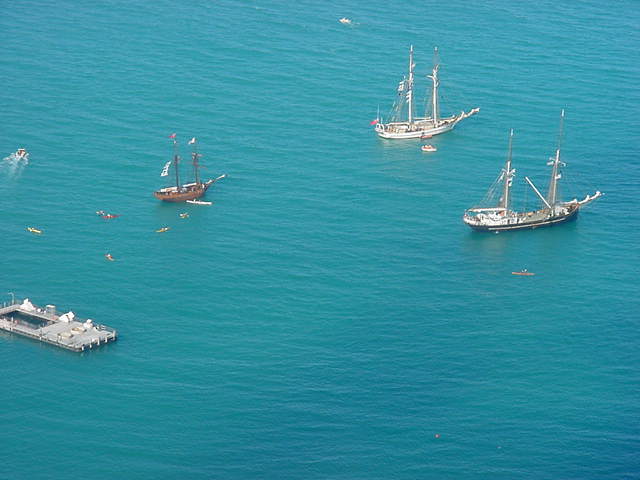
Three of the tall ships (left to right) Enterprize, One and All and Falie close to the shark aquarium platform at Granite Island.
I couldn’t get down to Victor myself that weekend but Evan John did. He flew down there from Noarlunga Airfield on Saturday 6th April in a De Havilland Chipmunk ("Chippie") which had been used as a training plane by the British in the 1960s. Evan is learning to fly a plane and, thankfully, he took some photographs down at Victor that day.
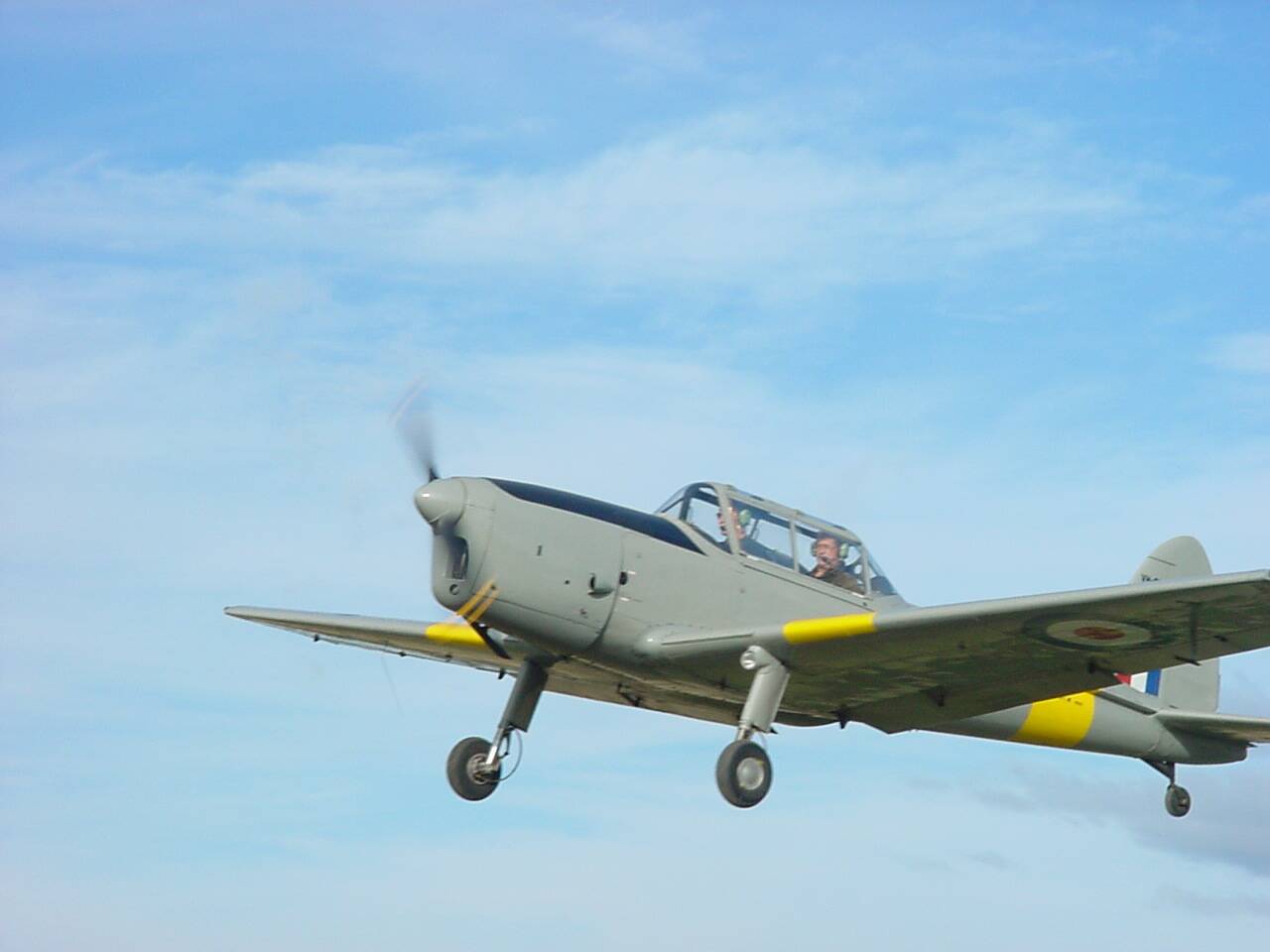
Chippie taking off
The plane was flown down to Granite Island at Victor Harbor where the four tall ships and the French Navy frigate Vendemiaire could all be seen anchored. The Enterprize, One and All and Falie were all anchored between the Below Decks Shark Aquarium platform, the Screwpile Jetty and the Granite Island breakwater. Several pleasure craft moved in close to the ships for a better view.
The five ships were then over at Port Elliot on Sunday 7th April for the official opening of the Flinders-Baudin lookout at Crowsnest Road in front of about 5,000 people. (I visited the lookout a little later on.)
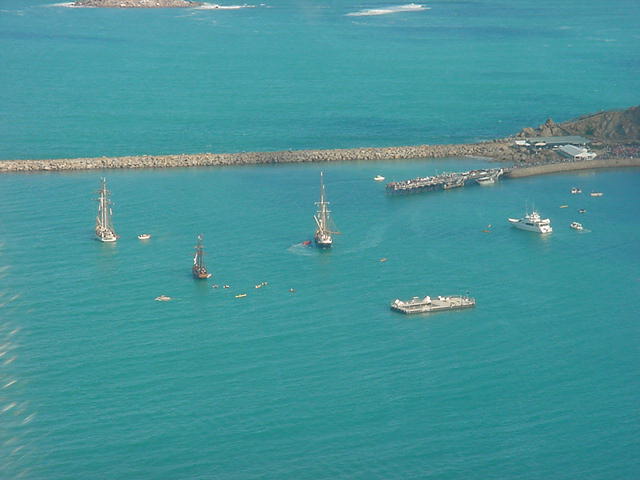
Several pleasure craft around the three tall ships (left to right)
One and All, Enterprize and Falie close to the breakwater.
Cleanup Dive At Port Hughes - 2/3/03
This year’s cleanup was about the 15th that I have been involved in one way or another. That’s one every year since 1989. Back then the cleanup was done in April as part of KESAB’s "Clean the Scene" campaign. Through the SDF, we did a cleanup dive along with the Triton club at Brighton jetty. We had seven members there on the day plus a few from Triton. In my report in the April newsletter (No.141) I said that "A few lessons were learnt on the day and should be helpful if we ever do another cleanup in the future". Little did I know what was in store for the next 14 years.
Clean Up Australia Day this year was held on Sunday 2nd March for the second consecutive year. We managed to have some 16 volunteers taking part. I had my wife and son-in-law to help out. Geoff brought along a few of his dive shop/club divers. Tim’s son Craig was there to assist. Chris’s partner Jean was also on hand to help out. Sharmila James continued her volunteering assistance by coming along for a dive with us. Just about everyone arrived at the jetty by 10.30am and it was a great get-together.
Once geared up, 11 divers entered the water from the jetty steps and proceeded to swim along the rest of the jetty. Two divers were taking photos and collecting rubbish as they went along. The rest either collected rubbish or aquarium specimens (or both). The specimens were being collected for the proposed aquarium display for the Ecology for Kids Day at the Women’s and Children’s Hospital which was later cancelled.
The sea was flat calm but the skies were somewhat overcast. We had fair visibility but we all did our best to stir things up down there. The depth was around about 6 metres at the end of the jetty.
The highlight of the dive (for me) was cuddling up to a 1m Port Jackson Shark at the end of the jetty, although sighting a small octopus, a tiny juvenile Scalyfin and several large Shaw’s Cowfish came a close second. There were lots of eggs in the water under the jetty. Some of them were still intact whilst others were broken. I think that there may have been large and small eggshells down there. The small ones would be from the numerous pigeons, which nest beneath the jetty.
One of my two buddies deserted me by following another diver in a similar wetsuit. My other buddy took me to a pile of bottles at the end of the jetty. We put them all into my rubbish bag and then tried to drag it back to the steps. It was only about half full but we really struggled to drag it along. We paused to look at the Port Jackson Shark once more before continuing.
We were both exhausted and thought that we must be close to the steps by now so we surfaced. We were still only halfway to the steps, so we inflated our BCDs and swam the rest of the way on the surface. The bag was heavy and if we stopped swimming we started to sink despite the air in our BCDs. It was a relief to get close to the steps where our esteemed leader dropped a grappling hook down on a line to us. The bag just needed a few more knife stabs to release water so that it was light enough to be lifted up to the jetty.
My buddy and I were now very tired but we could see several more bottles close to the steps so we continued to collect them. Some were put into another bag whilst others were just passed up onto the steps. I found Chris still taking photos so I relieved him of his rubbish bag and took it back to Sharmila who was waiting at the jetty steps. Chris had finally found a small pipefish in the Scaberia to photograph. Other divers were now returning to the steps so I took the opportunity to exit. I had spent around 85 minutes in the water.
The jetty crew did a great job. They sorted through all of the rubbish and loose dive gear. They then returned much of it all back to the car park, using my wheelbarrow with a flat tyre to carry everything. Philip (who said that the wheel on the barrow was only flat on the bottom) found an octopus in amongst the rubbish and returned it to the sea. Several photos of everyone and our 6 bags of rubbish were taken at the car park before the divers could finish changing out of their gear. Everyone was eager to have lunch and the barbecue was fired up. I had to leave after lunch but some others were staying so that they could have a second dive under the jetty.
I thank each of the other 15 volunteers for assisting on the day. They were: -
Noeleen Reynolds, Maggie McGilchrist, Tim Woonton, Craig Woonton, Peter Gower, Sharmila James, Philip Hall, Margaret Hall, Chris Hall, Jean Chamberlain, Steve Fellows, Geoff Prince, Mike Russell, Judith Rushton and Matt Hill.
Steve Reynolds

Committee Reports for 2002/2003
President - Philip Hall
A "Profit and Loss" record for this year would have to mention the following:
Profits
Would include an increase in membership and the number of visitors attending General Meetings;
Scoresby Shepherd becoming only our second Patron;
Continued income from the usage of our slides;
The sale of several JOTS books and the impressive use being made of the kits at the Nature Education Centre;
Calendar sales exceeding the cost of production;
Continued financial support for the calendar by PIRSA, and the agreement by the Marine and Coastal section of the DEH to assist it;
Sale of MLSSA pictures to Yankalilla Tourism for publicity purposes;
Our very successful stand at the Wirrina Dive Expo;
Clean Up Australia Day dive at Port Hughes;
Several visits by members to the Below Decks Aquarium for dives;
The Volunteer certificates from the Premier being presented to several members;
The impressive quality and variety of the speakers and their topics at our meetings;
The continued improvements to our website;
The visit to the RAH Hyperbaric Unit;
The increase in the number of requests for information or pictures by the general public and various organisations;
The presentation to Margaret Hall of the "2002 notable member" trophy;
Losses
Would have to include the cessation of diving activities due to concerns over insurance;
No Journal produced in 2002;
The balance is therefore certainly on the "Profit" side of the ledger.
Treasurer - Phill McPeake
This report will be presented at the AGM as a statement of accounts.
Secretary - Steve Reynolds
Another year has gone by quickly and it’s time to churn out an annual report again already. The first half of my report from last year still applies for this year. Only some of the year’s events and speakers have changed. In May last year we had Scoresby Shepherd speak to us about the Galapagos Islands. A few months later we decided to make Scoresby our Patron. It all became official in January this year when Scoresby was presented to our meeting as our second ever Patron. He was then on hand to present several volunteer certificates to society members. These certificates were actually Premier’s Certificates of Appreciation from Mike Rann, the SA Premier. Other guest speakers during the year have been Chris Halstead, Anthony Brown, Heidi Bartram, Elizabeth Reid, David Muirhead, David Walker, Jonathon Shankar-Noble and Ben Kear. At the time of writing David Offord is to be our April speaker. Members such as David, Chris and Ralph also gave slide and other reports/presentations of their own at meetings. My thanks to all of these people for their time and effort. Society highlights for the year include the Divers Forum at the RAH HMU, the clean up dive at Port Hughes (again), my attendance at the launch of the SA Moorings Program, the Christmas picnic at Victor (including another visit to the Oceanarium) and the Great Southern Dive Expo. Many thanks to everyone who assisted with the clean up dive. A lot of the above mentioned activities are bonuses for me. I really enjoy mixing with other society members at meetings (Committee & General), dives, events, etc.. Then there’s the work for calendars, the Photo Index, newsletters & Journals, minutes & agendas.
Committee Reports
David Muirhead
"As the years fly past
well we lose our grasp
or face it in the sun."
Neil Young
This quote speaks for itself eh?
I saw my share of sun, sand and sea, and again dived a lot but with far fewer metropolitan Adelaide dives.
Between (mainly) Chris Hall and myself the Index has shown healthy if erratic growth in content and increasing community and government application.
But the Index Website desperately needs overhauling in format and scientific accuracy if it is to remain a useful resource rather than an embarrassment. (No blame here, just stating facts.)
We've had an excellent series of speakers at our meetings but for me and doubtless many in MLSSA the years' peak achievement has been the securing of Scoresby as Patron. Though its been said before, MLSSA could not wish for a better endorsement of our Society's past achievements and future goals than have a Patron of this mettle. (But you Scoresby do have one fault - you're much too modest!)
All in all, another great year. If only work didn't get in the way . . . . .
Chris Hall
This last year 2002/03 has been an indifferent year for me as I’ve had lots problems with my underwater camera system. However as far as MLSSA is concerned this has been a good year for me.
Firstly the production of the 2003 calendar with my photograph on the front cover was a real thrill for me with all my family and friends saying how clever I was. Little do they know as far as underwater photography goes that I am amateur and not a very good one. I won’t tell them if you don’t?
I do think that this year’s calendar is the best produced so far and certainly will be hard to better. I’m also pleased that we have done reasonably well with selling them especially as we didn’t have the Mayer Krieg sponsorship. Well done to those of us that have sold so many and also to the production team for producing such a great calendar.
Secondly the general meetings have been excellent with a great range of diverse speakers mainly thanks to Steve and his endeavours to procure so many informative and interesting guest speakers.
Thirdly was the great attendance to Clean Up Day at Pt. Hughes and the fact the we are doing something for the environment even though there was not a lot of rubbish. While on the subject of the environment it was pleasing to see we got in a submission on the Fisheries Act as well as a letter of to the Minister in regard to Aquaculture in marine sensitive areas.
Lastly I would like to thank Scoresby Shepherd for accepting the role of Patron and all the committee members including Margaret for making MLSSA the success it is.
I would also like to thank all the members for their contributions over the last twelve months.
I have one further comment and it is not a criticism of anyone but something we should all work towards and that is having more social events and activities.
Non Executive Reports
Editor - Philip Hall
A welcome increase in the number of articles being submitted for the Newsletter by members was offset by our inability to publish a Journal for 2002 because of a lack of suitable articles.
The quality of the submitted articles has been excellent and they required little work by myself to prepare them for publication. They have all been put on our website and most pictures associated with them have been in full colour.
Our thanks must go to Phill McPeake for his continued printing of the Newsletter.
Library Officer - Steve Reynolds
There’s not too much to report regarding the Society’s library. It serves as a handy resource at times for the occasional enquiry. I get to use it a fair bit myself though. An updated list was posted on our web site recently. Take a look at the contents of the library. You may get a surprise and may even find something of interest listed there. Let me know if there’s anything that you would like to see or find out more about. I would also be quite receptive to any suggestions that anyone may have regarding the contents of the library. Technology is starting to influence the contents as more and more CDs, videos and DVDs are being held in the library.
Photo Index Officer - Steve Reynolds
I’m not sure that the Photo Index grew very much during the past year. There could be much more new input with a little effort but there also needs to be more work done on the identification of slides. We need to spend some time looking at the unidentified species in the Index. It is a valuable resource and a handy reference. It is used extensively for the calendars, talks, displays, illustrations, etc.. Just like our library, the Index is becoming more technological as we start to digitize our records. Phill McPeake will now be scanning slides for the Index.
SDF Rep - Steve Reynolds
I have continued to represent MLSSA at most SDF meetings through the past year. I was able to attend the majority of meetings. It was best that I did so as the Federation’s Secretary. We would hold an Executive Committee meeting for an hour prior to the holding of a two-hour plus meeting for club delegates. Major topics for the year included the Hobart, risk management, public liability insurance, dive standards and MPAs. I published a monthly electronic news sheet for the SDF which I was able to send out to our own members. I was also able to send them the SDF minutes that I prepared. I look forward to continuing in this way for our Society.
Membership Fees
These are now due and can be paid at the AGM or sent by post to:
The Treasurer
MLSSA
120 Wakefield Street
ADELAIDE
5000